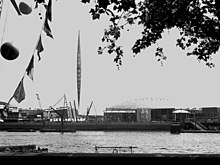Festival of Britain
The Festival of Britain was a national exhibition held in the United Kingdom in the summer of 1951. The festival was organized by the UK government to bring UK contributions to science, technology, design, architecture and the arts to a wide audience. The central venue was the South Bank on the Thames in London .
history
The National Exhibition of 1951 was intended to commemorate the first world exhibition of 1851, the Great Exhibition , and was originally planned for 1943. However, the exhibition was held only after the Second World War in 1951 during the reign of Prime Minister Clement Attlee . The focus of the exhibition shifted from international trade to promoting British identity and towards a forum for domestic industry. Former Home Secretary Herbert Stanley Morrison was appointed chairman of the planning committee. As advisors were u. a. the poet TS Eliot and the actor John Gielgud appointed. Architectural director was the artist and author Hugh Casson (1910–1999).
In just 22 months, the shabby Dockside South Bank on the Thames was transformed into a colorful exhibition space. The Festival of Britain had more than 8 million visitors. The attractions presented include a. the “Dome of Discovery”, a giant futuristic building with a planetarium, and the “ Skylon ”, a rocket-like or spaceship-like sculpture around a hundred meters high. In the Festival Pleasure Gardens, a miniature train designed by Rowland Emett , the "Far Tottering and Oyster Creek Branch Railway", carried over 2 million passengers over a distance of around 530 m.
Reuse
Opened on May 3, 1951, the Royal Festival Hall was a contribution by London County Council to the Festival of Britain and was the only permanent building.
Web links
- Martha Maria Gehrke: London celebrates and is happy , article in the magazine Die Zeit on June 7, 1951
- Festival of Britain. Pictures on Flickr. Retrieved November 25, 2016 .
Individual evidence
- ^ A b Marion Löhndorf: Festival on the river. London's Southbank Center commemorates the “Festival of Britain” from 1951. NZZ . June 11, 2011, accessed November 24, 2016 .
- ↑ The artist Rowland Emett (English Wikipedia) also designed a model sheet booklet for children in the Puffin Picture Books series , with which the train could be recreated from cardboard.
